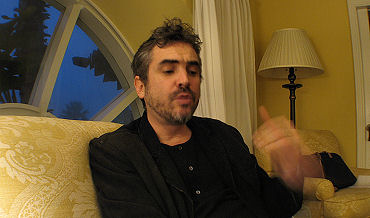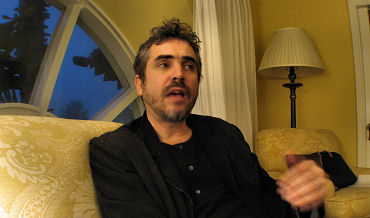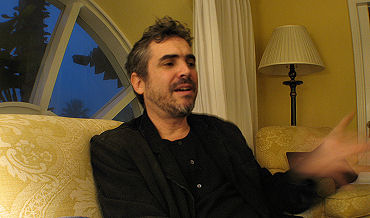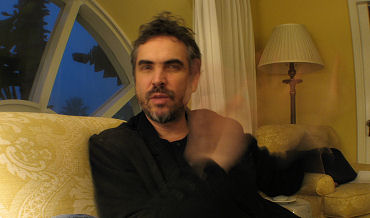Here’s a 39-minute portion of yesterday’s conversation with Children of Men director-cowriter Alfonso Cuaron. A lot of it won’t add up for those who haven’t seen the film, but Cuaron’s obvious intelligence and his very precise choice of words deliver a kind of contact high if you listen for a few minutes. That and his laughter, which has a wonderful eruption and spontaneity.

Cuaron really knows his stuff, and he obviously respects to the nth degree and swears by the great Emmanuel “Chivo” Lubezki, his director of photography who refused to use any sort of artificial lighting or green screens in the making of Children of Men. This is a film that uses CG visuals allthrough it, but with one or two exceptions it’s very hard to identify them.

Cuaron’s long experience making Harry Potter and the Prisoner of Azkaban provided a master course in state-of-the-art visual effects, and strengthened his hand in discussing what was possible or not possible in the making of Children of Men. But I’m delighted that he and “Chivo” were dead-set against using anything that looked in the least bit like a visual effect. (One surprise for me is that a bit in which Clive Owen and Julianne Moore play a mouth-to-mouth game of “catch” with ping-pong balls is digitally composed.) And I love that Cuaron values (along with “Chivo” and their collaborator and unofficial co-writer Clive Owen ) the on-camera benefits of minor filming accidents.

And I loved that when I mentioned the apparent influence of Stanley Kubrick‘s Full Metal Jacket in Men‘s final battle sequence, Cuaron said that the bigger visual references in the making of this film were Kubrick’s A Clockwork Orange (because of the futuristic-but-battered London settings) and F.W. Murnau‘s Sunrise.

We talked about how some older viewers have expressed dismay or outright dislike, even, for the sense of futility that, in their opinion, the film imparts. It’s obvious to me that anyone who comes away with this view isn’t paying attention. “This film has gotten very strong reactions — younger people find the film hopeful, older people find the film very depressive,” Cuaron admits.

“I’ve heard people say this is just another chase movie. It’s like people are so jaded about the telling of pictures. As opposed to have to engage with the specific cinematic elements and different approaches. I have a very bleak view of the present, but a very hopeful view of the future. For me the film is about hope in the end, but you cannnot dictate a sense of hope in a viewer because that is very personal and internal. [In our film] we basically allow audiences to fill in the blanks and make their own conclusions.”

I mentioned that the head of a distribution company who saw Children of Men at the Venice Film Festival recently complained that it departed significantly from the P.D. James novel. “We used the premise…only the premise of female infertility,” Cuaron responded. “But we received a statement from [original author] P.D. James, saying she fully admires and is pleased with the film and is very proud to be associated with it. For which I’m very thankful.

“I was not interested in constructing a back-story [about what caused female infertility],” Cuaron says. “Because if I did that, a lot of the movie would then have to be about that. For me, female infertility was basically a metaphor for the fading sense of hope. And the Human Project…if I have to explain who they are and the whole background of that, that also would have consumed a significant portion. The Human Project is a metaphor for human understanding. For me that was sufficient.”
